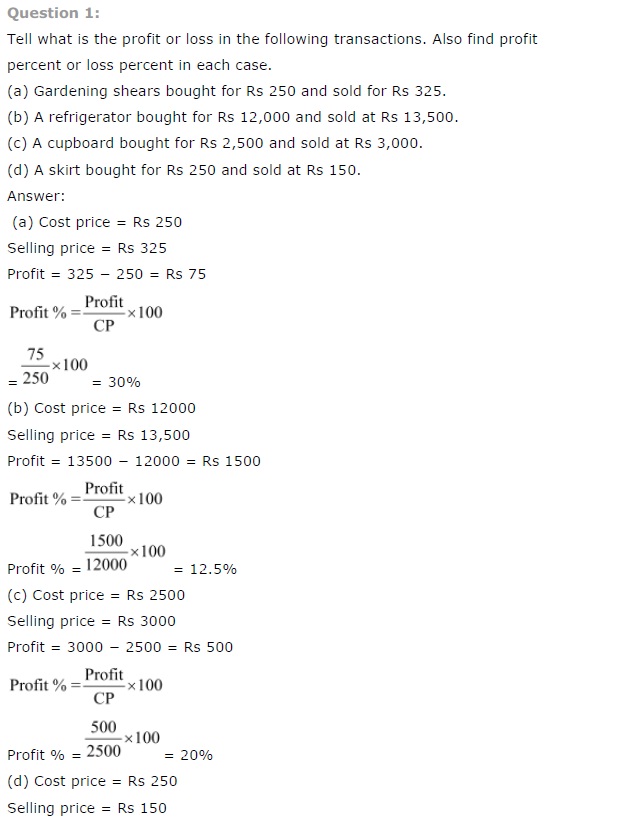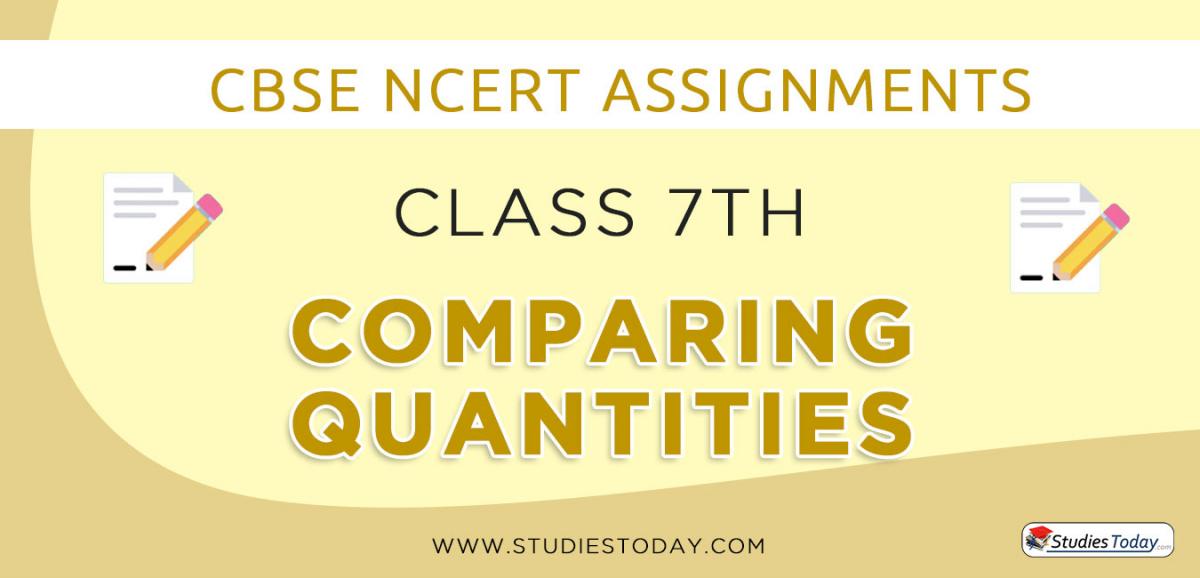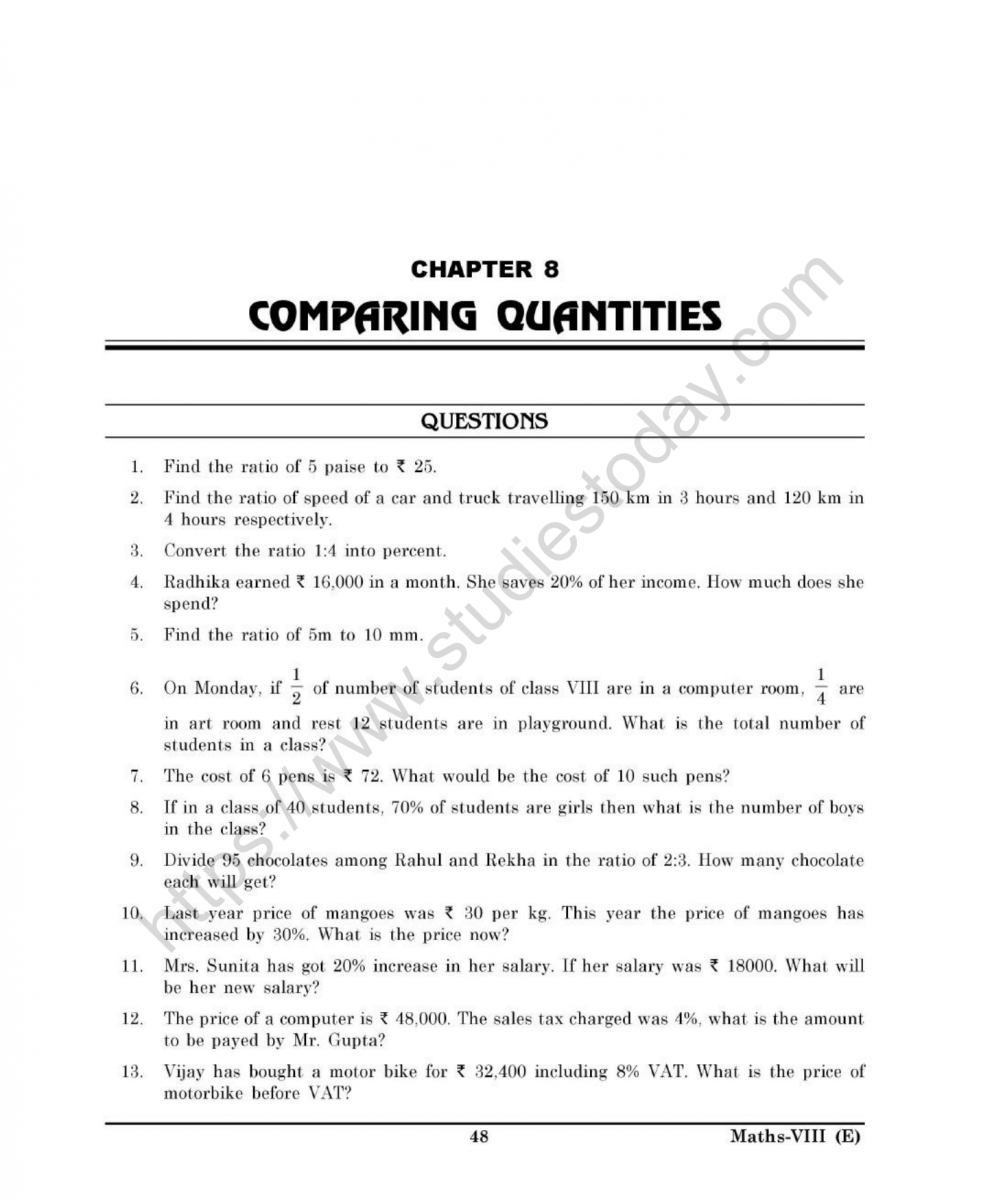
NCERT Exemplar Solutions for Class 7 Maths Chapter 7 Comparing Quantities download free PDF
1 Class 7 Maths | Chapter 8 Comparing Quantities | Extra Questions For Practice by Sanjusha · November 15, 2019 Answer the following: 1. Find the ratio of each of the following in simplest form: a) Rs 5 to 50 paise b) 18 m to 36 cm 2. Check whether the following ratios are equivalent: a) 2:3 and 12:18 b) 4:7 and 9:12 3.

NCERT solution for class 7 Maths Comparing Quantities Exercise 8.2
Solution 11. NCERT Solutions for Class 7 Maths CBSE Chapter 7: Get free access to Comparing Quantities Class 7 Solutions which includes all the exercises with solved solutions. Visit TopperLearning now!

NCERT Solutions for Class 7 Maths Chapter 8 Comparing Quantities
NCERT Solutions for Class 7 Maths Chapter 8 Comparing Quantities Ex 8.1. Ex 8.1 Class 7 Maths Question 1. So, required ratio is 10 : 1. So, the required ratio is 500 : 7. So, the required ratio is 100 : 3. So, the required ratio is 20 : 1. Ex 8.1 Class 7 Maths Question 2. In a computer lab, there are 3 computers for every 6 students.

NCERT Solutions for Class 7th Maths Comparing Quantities Exercise 8.3 NCERTSolutions
Here we have given NCERT Exemplar Class 7 Maths Solutions Chapter 7 Comparing Quantities NCERT Exemplar Class 7 Maths Solutions Chapter 7 Comparing Quantities Directions: In questions 1 to 23, there are four options, out of which one is correct. Write the correct one. Question 1. 20% of 700 m is (a) 560 m (b) 70 m (c) 210 m (d) 140 m Solution:

NCERT Solutions for Class 7 Maths Chapter 8 Comparing Quantities Ex 8.3
Students can also refer to NCERT Solutions for Class 7 Maths Chapter 8 Comparing Quantities for better exam preparation and score more marks. Comparing Quantities Class 7 MCQs Questions with Answers. Comparing Quantities Class 7 MCQ Question 1. The ratio of Rs 10 to 50 paise is (a) 20 : 1 (b) 10 : 1 (c) 5 : 1 (d) 1 : 20. Answer. Answer: (a) 20.

Assignments for Class 7 Comparing Quantities PDF Download
Exercise 8.1 Solutions Exercise 8.2 Solutions Exercise 8.3 Solutions Access Answers to Maths NCERT Solutions for Class 7 Chapter 8 - Comparing Quantities Exercise 8.1 Page: 157 1.

COMPARING quantities Class 7 Brainly.in
What's in it? Updated for new NCERT Book. Get NCERT Solutions of Chapter 7 Class 7 Comparing Quantities free at Teachoo. All exercise questions and examples have been solved with step-by-step explanation of each question. Concepts are also explained before the questions. In this chapter, we will learn What is ratio, how to find ratio

NCERT Solutions for Class 7 Maths Chapter 8 Comparing Quantities Free PDF
Comparing Quantities Class 7 Extra Questions Very Short Answer Type. Question 1. Find the ratio of: (a) 5 km to 400 m (b) 2 hours to 160 minutes Solution: (a) 5 km = 5 × 1000 = 5000 m Ratio of 5 km to 400 m = 5000 m : 400 m = 25 : 2 Required ratio = 25 : 2 (b) 2 hours = 2 × 60 = 120 minutes
.jpg)
Comparing Quantities NCERT Book of Class 7 Mathematics
NCERT Exemplar Class 7 Maths is very important resource for students preparing for VII Board Examination. Here we have provided NCERT Exemplar Problems Solutions along with NCERT Exemplar Problems Class 7. Question from very important topics are covered by NCERT Exemplar Class 7.

Cbse Class 7 Maths Comparing Quantities Worksheets Pdf Donald Lawlor's Math Worksheets
Comparing Quantities Class 7 Extra Questions Very Short Answer Type Comparing Quantities Class 7 Worksheet Question 1. Find the ratio of: (a) 5 km to 400 m (b) 2 hours to 160 minutes Solution: (a) 5 km = 5 × 1000 = 5000 m Ratio of 5 km to 400 m = 5000 m : 400 m = 25 : 2 Required ratio = 25 : 2 (b) 2 hours = 2 × 60 = 120 minutes

NCERT Exemplar Solutions for Class 7 Maths Chapter 7 Comparing Quantities download free PDF
EXAMPLE 1: Two numbers are in the ratio 1:23. On adding 4 to the first and 5 to the second, their ratios become 1:13. Find the numbers. Hence, the numbers are 4.7 and 23X4.7= 108.1 [ANS] EXAMPLE 2: Out of the salary of Rs.123456, I kept 1/2 as savings. Out of the remaining money, I spend 47% on food and 18% on rent.
NCERT Solutions Class 7 Mathematics Comparing Quantities
NCERT Class 7 Maths Unit 7 is for Comparing Quantities. The type of questions that will be asked from NCERT Class 7 Maths Unit 7 are displayed in the below provided NCERT Exemplar Class 7 Maths Unit 7. With the help of it, candidates can prepare well for the examination. Also Check: NCERT Solutions Class 7 Maths Main Concepts and Results

Comparing Quantities Class 8 Extra Questions Maths Chapter 8 CBSE Labs
Class 7 Unit 7: Comparing Quantities 400 possible mastery points Proficient Attempted Not started Start Comparing Quantities 7.1 Practice Not started Percent word problem: penguins Finding profit percent Intro to simple interest Finding simple interest for one year Finding simple interest for many years Practice Practice Not started Not started

NCERT Exemplar Class 7 Maths Unit 7 Comparing Quantities AglaSem Schools
Unit 1 Integers Unit 2 Fractions and decimals Unit 3 Data handling Unit 4 Simple equations Unit 5 Lines and angles Unit 6 The triangle and its properties Unit 7 Comparing quantities Unit 8 Rational numbers Unit 9 Perimeter and area Unit 10 Algebraic expressions Unit 11 Exponents and powers Unit 12 Congruence of triangles Course challenge

Class 7 Important Questions for Maths Comparing Quantities AglaSem Schools
Important Questions Class 7 Mathematics Chapter 8 - Comparing Quantities Mathematics is an important subject that students study in school. It is not a subject that students study in school, but rather one that we require in everyday life.It helps us solve daily life's problems with more complicated issues in technology, construction, or.

NCERT Exemplar Solutions for Class 7 Maths Chapter 7 Comparing Quantities download free PDF
Chapter 7 - Comparing Quantities is defined as a ratio, which is a comparison between two or more like quantities in the same units. This suggests that a ratio can be simplified by dividing its terms by the same number, and therefore, the terms of a ratio can be multiplied by the same number.